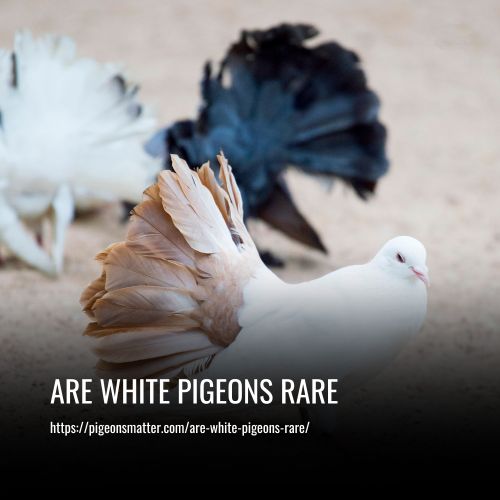White pigeons are not necessarily rare, as different breeds of pigeons come in various colors, including white. However, certain breeds of white pigeons, such as the White King pigeon, may be less common and considered more rare.
The prevalence of white pigeons can fluctuate depending on their location and circumstances, but they are not considered a particularly uncommon species. While they may not be as common as other pigeon breeds, white pigeons are not a distinct breed, but rather a variation in color from other breeds.
White feathers occur naturally in many pigeon breeds, but selective breeding for specific traits like homing or show quality has made them more prevalent in certain populations.

History Of White Pigeons
White doves have a rich history in the world of pigeon breeding. Breeders have long been interested in developing new and unique breeds of pigeons, often through selective breeding for specific colors or patterns. This has led to various breeds of white pigeons, each with their distinct characteristics.
The demand for white doves as release birds for weddings and other ceremonies has been increasing in recent years. These birds are seen as a symbol of love, peace, and new beginnings. As a result, the breeding of white pigeons has become increasingly popular in some areas.
While white doves may have originally been bred for their looks or homing ability, they now serve a special purpose in celebrations and events. Their association with love and new beginnings has made them a meaningful addition to many ceremonies and an important part of our cultural traditions.
What Makes a Pigeon White?
There are a few different reasons why pigeons can be white. Some pigeons may be white due to genetic conditions like albinism or leucism. In the case of albinism, a genetic mutation causes the absence of pigment-producing cells in the pigeon’s body. This results in a complete lack of color and often leads to pink or red eyes and flesh-colored skin and body parts.
Leucistic pigeons, on the other hand, lack melanin-producing cells in their feathers. This can result in white feathers, but these birds may still have small patches of dark coloration on other parts of their body.
One way that pigeons can be bred to be white is through selective breeding. The king pigeon breed, for example, was developed in the USA in the 1890s by crossing four different pigeon breeds. These birds are selectively bred for their beauty, and white is a popular color variation.
So, whether it’s due to genetics or selective breeding, there are a few different reasons why pigeons can be white in color.
Do They Occur Naturally In The Wild?
While only 1% of wild pigeons are considered white, doves used in ceremonies such as weddings or christenings are selectively bred to be small and white. These birds, called Release Doves, are released at ceremonies to symbolize a prayer being sent up to heaven or as a symbol of peace being released into the world. However, many of these birds are killed in transit or lack the experience to survive in the wild, leading to concerns from animal cruelty charities.
If you see a white pigeon that is significantly smaller than an average pigeon, it is likely a released dove. The practice of breeding doves solely for release at ceremonies is controversial and has led to efforts to stop the practice. It’s important to consider the well-being of these birds and their ability to survive in the wild before using them in ceremonies.
How Rare Is It To See A White Pigeon In The Wild?
White pigeons are a rare sight in the wild due to their unique genetic combination that causes either albinism or leucism. These conditions are not common in the wild, making it rare to see a white pigeon in its natural habitat.
However, release doves are often white due to selective breeding by breeders who aim to produce birds with this coloration. As a result, white pigeons are more commonly seen in captivity or during special events where release doves are used.
Why are White Pigeons Rare?
Albino pigeons are a rare sight due to several reasons. For a pigeon to be Albino, both parent pigeons must possess the rare Albino gene. This makes it difficult for Albino pigeons to breed and continue the genetic trait.
The white color of Albino pigeons makes them visible to predators, making survival challenging. Additionally, their poor eyesight makes it difficult for them to see predators and escape from them.
The absence of melanin in their feathers also makes them weak, which further reduces their chances of survival in the wild.
Unfortunately, Albino birds are often culled by breeders due to their unattractive appearance and the fear that the entire brood may become Albino if they are allowed to mate.
Why White Pigeons Are So Special?
Pigeons are incredibly intelligent birds, with impressive intellectual capacity and long-term memory. They are capable of completing tasks that most birds cannot, such as the mirror test and distinguishing between letters and photos. White pigeons, in particular, have unique characteristics and symbolisms that make them popular pets.
White pigeons are commonly linked to the concept of peace and are known as the “dove of peace” or “white doves”. They radiate a sense of serenity wherever they fly, making them a beloved symbol of peace.
In addition to peace, white pigeons are also associated with fertility, purity, and prosperity. They are considered to be a symbol of the holy spirit, adding to their spiritual significance.
Overall, white pigeons are intelligent and unique birds with powerful symbolisms that make them a popular choice for pets and a beloved symbol of peace and spirituality.
Origins of the White Pigeon
White doves and pigeons are actually barbary doves that have been selectively bred to make the albino genes dominant. Breeders also attempt to accentuate their small size to make dove release ceremonies easy and delicate.
Although white doves have held significant symbolism in religion and spiritualism for centuries, the breeding of pure white pigeons for even starker symbolism is a more recent trend.
Unfortunately, the process of releasing birds ceremonially is now recognized as unethical and dangerous. It’s important to consider alternative ways to honor traditions without putting these birds at risk.
Distribution And Habitat of the White Pigeon
White pigeons are commonly found in domestic settings and can be found worldwide.
The sighting of a white pigeon in the wild could indicate that it has not returned home after being released. These birds are not well-equipped to survive in the wild, which is why release ceremonies are often criticized.
It’s important to remember that pigeons are domesticated animals and should be treated as such. If you come across a lost or injured pigeon, it’s best to contact a local wildlife rehabilitation center for assistance.
The appearance of the White Pigeon
The white pigeon is a delicate-looking bird that is often used symbolically. Its appearance is consistent with its symbolic representation, being dainty and elegant. This breed is completely white, with pink legs and a small beak. They are smaller than most other pigeon breeds.
The character of the White Pigeon
The release of white pigeons is often used as a symbol of peace, love, and unity. However, the act of releasing them can have negative consequences.
White pigeons lack the homing instincts and flight abilities of their wild counterparts, rendering them unable to survive in the wild as domesticated birds. They are also easily targeted by predators due to their white color.
There have been instances of white doves being attacked immediately after their release, causing harm to the birds. Even the Vatican, which used to schedule dove releases for special holidays, has stopped doing so due to incidents of attacks on the birds.
Using white pigeons in release ceremonies may seem like a beautiful gesture, but it is important to consider the well-being of the birds and find alternative ways to symbolize peace and unity.
Diet of the White Pigeon
Like most other pigeons, white pigeons have a varied diet that includes seeds, grains, berries, leafy greens, chopped-up fruit, and chopped-up vegetables.
For optimal digestion, it is necessary to consistently offer them fresh drinking water and grit. By offering a balanced diet, you can help ensure that your white pigeon stays healthy and happy.
Breeding And Caring For White Pigeons
Raising White Pigeons is a straightforward process that requires a few basic elements. Providing a comfortable living space, a balanced diet, and regular exercise are the key components.
Maintaining a clean living environment is essential for their overall health and wellness, as pests can pose a significant threat. Social interaction is also important, as White Pigeons are social birds that thrive in pairs or groups.
By following these simple guidelines, you can ensure that your White Pigeons are happy and healthy.
Taking Care of White Pigeons
When caring for a white pigeon in captivity, it’s important to provide them with enough space to fly and move around freely. Soft materials on the ground, such as straw or sawdust, can help prevent injuries and provide a comfortable resting area. Perching and nesting areas should also be provided to promote natural behavior and comfort.
Regular access to food and water is essential for the health and well-being of the pigeon. It’s important to provide a balanced and nutritious diet, including grains, seeds, and fresh fruits and vegetables. Clean water should be provided daily to prevent dehydration and promote good health.
Caring for a white pigeon in captivity is similar to caring for other breeds of pigeons. Providing a safe, comfortable, and stimulating environment can help ensure their happiness and well-being.
FAQs
Yes, white pigeons are often seen as symbols of peace, love, and purity in various cultures worldwide. They are sometimes released at ceremonies or events as a symbol of hope or a peaceful gesture. In some cultures, they are associated with religious ceremonies or traditions.
White pigeons have the same abilities as other pigeons to survive in urban or rural environments. However, their white color might make them more visible to predators, potentially making them more vulnerable. In areas where there is less predation and suitable food sources, white pigeons can survive and thrive.
Not necessarily. White pigeons can belong to various breeds, and not all of them are homing pigeons. Homing pigeons are a specific breed that has been selectively bred for their ability to find their way home over long distances.
Yes, white pigeons can be kept as pets. They are social birds and can make enjoyable companions. However, it’s essential to provide them with adequate care, shelter, food, and companionship if kept in captivity, just like any other pet bird.
Conclusion:
While white pigeons may not be as common as their gray counterparts, they are not necessarily rare. They can be found in many parts of the world and are even bred specifically for their unique coloration.
So next time you spot a white pigeon, take a moment to appreciate its beauty and know that they are a special sight to behold.



